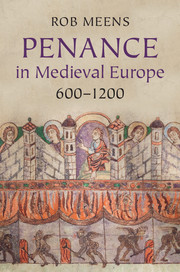Book contents
- Frontmatter
- Dedication
- Contents
- List of Figures
- Acknowledgments
- 1 Introduction
- 2 The late antique legacy
- 3 A new beginning? Penitential practice in the insular world
- 4 Insular texts on the move: penance in Francia and England
- 5 Penance and the Carolingian Reforms
- 6 New penitential territories: the tenth and eleventh centuries
- 7 The twelfth century
- Conclusion
- Appendix 1 The manuscripts of Theodore’s penitential
- Appendix 2 The manuscripts of the Excarpsus Cummeani
- Appendix 3 The manuscripts of the Bede and Egbert penitentials
- Appendix 4 The manuscripts of Halitgar’s penitential
- Sources
- Bibliography
- General index
- Manuscript index
- References
7 - The twelfth century
Published online by Cambridge University Press: 05 August 2014
- Frontmatter
- Dedication
- Contents
- List of Figures
- Acknowledgments
- 1 Introduction
- 2 The late antique legacy
- 3 A new beginning? Penitential practice in the insular world
- 4 Insular texts on the move: penance in Francia and England
- 5 Penance and the Carolingian Reforms
- 6 New penitential territories: the tenth and eleventh centuries
- 7 The twelfth century
- Conclusion
- Appendix 1 The manuscripts of Theodore’s penitential
- Appendix 2 The manuscripts of the Excarpsus Cummeani
- Appendix 3 The manuscripts of the Bede and Egbert penitentials
- Appendix 4 The manuscripts of Halitgar’s penitential
- Sources
- Bibliography
- General index
- Manuscript index
- References
Summary
The twelfth century is often seen as a revolutionary age in which a static archaic society changed into a dynamic one laying the foundations for modern society. There has been ample discussion about the exact moment when these revolutionary changes began as well as about the causes for this development, but that demographic and economic growth, urbanization, the development of new institutions such as universities and new religious orders had a great impact on medieval society is generally accepted. The clarity of the divide between the earlier period and the later one, however, has recently become subject to debate. A lot of work on the early Middle Ages stresses the dynamics of this period, thus adding nuance to the notion of a sharp break between the early Middle Ages and the later ones. Nevertheless, the twelfth century is deservedly known as an ‘age of renaissance and renewal’ and this is also true for the history of penance in this period. This chapter tries to outline the new developments in the field of penance and confession and to assess the impact of these changes on religious experience in this century and beyond. Because of the multitude of sources from this period, which is a reflection of the growing use of the written word accompanying the major changes in society, this chapter cannot be as comprehensive as earlier chapters. It will necessarily probe into some topics more than others and rely more on secondary sources than on a fresh analysis of the primary sources.
- Type
- Chapter
- Information
- Penance in Medieval Europe, 600–1200 , pp. 190 - 213Publisher: Cambridge University PressPrint publication year: 2014
References
- 1
- Cited by



